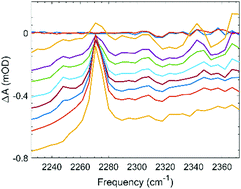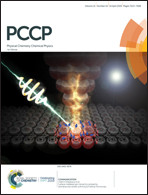The primary photo-dissociation dynamics of carboxylate anions in aqueous solution: decarboxylation†
Abstract
We study the primary photo-dissociation of aqueous anions of formic, acetic and propionic acids induced by photo-excitation at 200 nm. The photo-dissociation dynamics are recorded with sub-picosecond time resolution by UV pump–IR probe transient absorption spectroscopy. Hundred picoseconds after the excitation, 47 ± 5% of the excited formate anions, 35 ± 5% of the excited acetate anions and 27 ± 5% of the excited propionate anions are dissociated, while the rest of the excited molecules return to the electronic ground state of the parent anion. Photo-dissociation of the three anions produces CO2(aq) through a precursor with a lifetime of approximately 20 ps. The precursor is assigned to the excited state of the parent anion based on comparison with calculated IR spectra and isotope shifts. Of the molecules that remain dissociated after 100 ps, the percentage leading to the production of CO2(aq) is 7 ± 3%, 48 ± 20% and 92 ± 30% for formate, acetate and propionate, respectively, while photo-dissociation of formate in addition leads to formation of CO2−. Decarboxylation is thus the dominating reaction channel in acetate and propionate, and this suggests formation of CH4 and C2H6 when the initially formed anions are protonated by water.

- This article is part of the themed collection: 2019 PCCP HOT Articles


 Please wait while we load your content...
Please wait while we load your content...